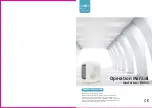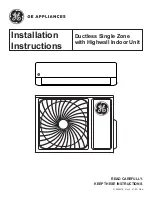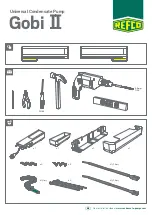
68
8 - MAINTENANCE
Maintenance must be done by authorized centres or by
qualified personnel
The maintenance enables:
- maintain the unit efficiency
- Reduce the deterioration speed to whom every
equipment is subject over time
- assemble information and data to understand the
status of the unit efficiency and avoid possible
damages
8.2 - GENERAL
The inspections should be carried out at least:
- Every year for only the cooling units
- Every six months for the cooling and warming units
The frequency, however, depends on the use.
in the event of frequent use it is recommended to plan
inspections at close intervals:
- frequent use (continuous or very intermittent use, near
the operating limits, etc)
- critical use (service necessary).
8.3 - INSPECTIONS FREQUENCY
It’s advisable to create a unit booklet to take notes of the unit
interventions.
In this way it will be easier to adequately note the various
interventions and aid any troubleshooting.
Report on the booklet:
- data
- type of intervention effected
- intervention description
- carried out measures etc.
8.4 - UNIT BOOKLET
If a long period of inactivity is foreseen:
- Turn of the power in order to avoid electrical risks or
damages by lightning strike
- avoid the risk of frost (empty or add glycol to the parts
of the system exposed to temperatures below zero,
maintain any anti-freeze resistances powered)
It’s recommended that the starter after the period of detention
is made by a qualified technician, especially after seasonal
stops or seasonal switch.
When starting, refer to that indicated in the START-UP
section .
Schedule technical assistance in advance to avoid hitches
and to guarantee that the system can be used when required
8.5 - STANDBY MODE
Check:
- ensure that the fan and the relative protection grids are
well fixed
- The fan bearings (evident by noise and anomalous
vibrations )
- the terminal protection covers are closed and the cable
holders are properly positioned
8.6 - OUTDOOR UNIT FAN
Accidental contact with the exchanger flaps can cause injuries
from cut: use protective gloves.
The coil must allow maximum thermal exchange, therefore,
the surface must be clear from dirt and scaling.
Clean the air inlet side.
Use a soft brush or aspirator or pressurised air jet or high-
pressure water jet machine.
Keep the direction parallel to the flow of the flaps to avoid
damages.
Check the aluminium flaps have not been damaged or folded,
on the contrary contact an authorised after-sales assistance
centre to "comb" the coil for excellent air flow.
8.7 - OUTDOOR UNIT AIR COIL
8.8 - CONDENSATE DRAIN
Dirt or scale can give rise to clogging.
Also, microorganisms and mould can flourish in the bowl.
Foresee periodical cleaning with suitable detergents and,
eventually, disinfect with sanitising products.
Once cleaning is completed, pour water inside the bowl to
check the regular outflow.
Summary of Contents for PAC BT Series
Page 1: ...Installation and operating manual PAC BT 5 kW to 17 kW M0GC6UN16 02 Nov 2016 English version...
Page 2: ......
Page 4: ......
Page 87: ...Airwell Residential AWAU PAC BT UE 5KW H11 AWHK PAC BT UI 5 9KW H11 42 64 3 4 5 XL kW kW kW...
Page 91: ...Airwell Residential 42 64 4 5 7 XL kW kW kW AWAU PAC BT UE 7KW H11 AWHK PAC BT UI 5 9KW H11...
Page 95: ...Airwell Residential 42 64 5 6 8 XL kW kW kW AWAU PAC BT UE 9KW H11 AWHK PAC BT UI 5 9KW H11...
Page 111: ......
















































